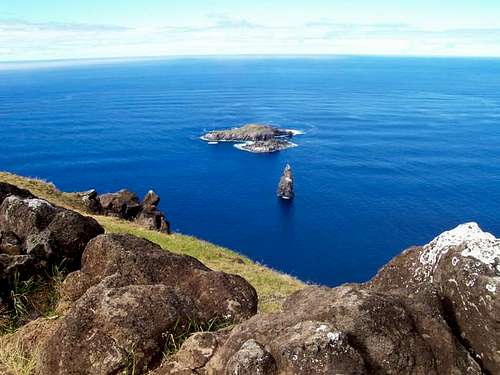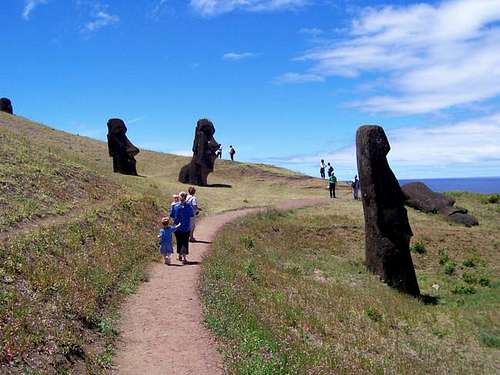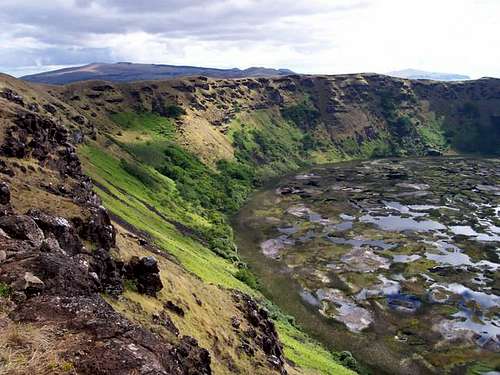|
|
Area/Range |
|---|---|
|
|
27.0952°S / 109.3673°W |
|
|
Hiking |
|
|
Spring, Summer, Fall, Winter |
|
|
1676 ft / 511 m |
|
|
Introduction
None of the peaks on Easter Island are very high, but all are very, very interesting. There are three main volcanoes that make up the triangular-shaped island (one for each corner), as well as several other sub-peak volcanic cones scattered across the island. The three main peaks are; Maunga Terevaka, Rano Kau, and Maunga Pukatikei.Easter Island was colonized around AD 300 by Polynesians from Marquesas or Mangareva. The long platforms (ahu) and the statues (moai) constructed at Ahu Akiva, were the last of all the ahu and moai on all of Easter Island and were constructed around 1460 AD. Other statues around the Island were constructed as early as 690 AD. These statues were portraits of known ancestors, were considered "living", and they looked towards a village to protect them.
After about 1460 AD, the demise of the culture of the island began in earnest. Since the native peoples had cut down all the native forest, there was no way to escape the island. Over population led to tribal wars and cannibalism. Around 1460, it was thought that about 20,000 people lived on the island. By the time the Europeans (Jacob Roggeveens) arrived in 1722, the population was around 4000. In 1862, a fleet of Peruvian black-birders kidnapped 1400 of the people (known as Rapanui) to work in the sugar plantations of Peru, and to work on off-shore guano mines. Included were the king and all of the learned class. Missionaries and diplomats in Peru protested, and eventually the 15 survivors were returned, but this set of a smallpox epidemic. French Catholic missionaries and Tahiti businessmen continued to remove the native Rapanui starting in 1866. When some were returned to their homeland, they introduced leprosy, and by 1877 the entire native population of Easter Island was reduced to 110 persons.
In 1883 Chile defeated Peru and Bolivia in the Pacific War, and in 1888 Chile annexed the island, thinking it could be used as a port for travel to the Panama Canal. There was no place for a safe harbor, so they leased the island to a British wool operation, which controlled the island until 1953. Unfortunately, during this time period, the Rapanui people were not allowed to leave the capital town of Hanga Roa. The first Rapanui governor was Sergio Rapu in 1984, and now the Rapanui people once again control most of the island. The current population is about 4500 people, and there is only one town on island, Hanga Roa.
All the Moai statues on Easter Island were carved from Rano Raraku. Some were moved up to 18 kms/11 miles away. How the natives did this is still a mystery, but some theories range from rolling them on logs, walking them with huge ropes, and extra-terrestrial/alien help. Since none of these has been proven conclusively, choose a theory to believe after doing your research.
A total of 397 statues are still at Rano Raraku, and there may still be more that are buried. The statues are at various stages of completion; many are complete, but some are still embedded in the cliffs of the peak and were never finished. Along the main trail described on this page, you will pass 70 standing statues, and 30 lying face down on the ground. The largest of the statues was never finished and remains buried in the cliff. It is 20.6 meters/68 feet long.
Just north of Maunga Pukatikei is Vai A Heva, a huge carved head in the rock. This is on the route described to the summit of the peak. I am not sure when the carving was made, nor its significance since I haven’t found any information on the site, and the tour groups don’t make it out there.
The site known as Orongo is on the summit of Rano Kau. Orongo was the main ceremonial site on the island and many petroglyphs of the "birdman" or on the stones surrounding the rim of the volcano. There are ruins of 47 stone dwellings on the summit of Rano Kau. For every September between 1460 AD and 1866 AD (406 years!), there were birdman festivals on the peak. A race was staged where the participants would make the dangerous swim to the off-shore island of Motu Nui to find the first egg of the sooty tern bird. The winning participant would then carry the egg to the top of the peak Rano Kau and would be proclaimed as "birdman". The winner was thought to posses supernatural powers.
This is a mountain page, not a history book, so all the above is just a very brief overview. I highly recommend that you read up using several good books on the fascinating history of the island before your trip.
Getting There
The only way to get to Easter Island is by plane and LAN Airlines. I didn't have much luck trying to book online, but calling LAN is easy. The airline has flights twice a week between Santiago Chile, Easter Island (Hanga Roa), and Papeete Tahiti. The cost varies depending on the time of year, and we paid about $500 in November from Tahiti. Usually it cost about $100 more round trip from Santiago, because the flights are in more demand. Note: If searching online, note that it is cheaper to search and book the flights seperately, such as your city to Santiago (Chile) or Papeete (Tahiti) and then a seperate booking to Easter Island. Interestingly, the runway at Hanga Roa is the second longest in the entire Pacific. The US government expanded the runway in 1986 as an emergency landing spot for the NASA Space Shuttles!Once you are on the island there are several choices for getting around. One is via a tour group and many of these are based in the only town on the island, Hanga Roa. Another way is to walk, but distances are long to some areas. Another way is via mountain bike. A modern high quality mountain bike cost $13 a day to rent in November 2005. If you want some exercise, this is an excellent way to get around, and is highly recommended. Unlike the rest of Polynesia, Easter Island is not unpleasantly hot all year. You can rent a car or take a taxi. Taxis are pretty reasonably priced here. You can also hitch hike. There is no public transportation on the island. Note that the roads on the island aren't posted and don't seem to have names, so they are identified by location (i.e. South Coast).
Where to Stay
There are campgrounds at Rano Raraku and at Anakena Bay on the north side of the island. Some of the budget guesthouses in Hanga Roa allow camping as well. Chez Cecilia is one place that caters to campers.Note that if staying on Easter Island, there is no need to have a hotel reservation as there are many more rooms than there are flights available to fill them. The hotels that are on travel websites are not as good as value as the homestays. Many of the homestays/guesthouses will meet you at the airport. We paid $50 a night for two children, two adults, breakfast for all, and transport to and from the airport.
Food is expensive on the Island, at least by Chile standards.
When to Visit
Anytime is a good time to come to Easter Island. The weather is about as perfect as it gets, at least temperature-wise. When we were there in November, the nights were around 20C (68F), and the days were around 24C (74F). It doesn't get much better than that anywhere in the world.It actually rains an average of 140 days at Hanga Roa per year, but since the rocks are so porous, mud isn't really a problem, and the rain doesn't affect you too much when you are out hiking or climbing.
March to June are usually the wettest months, and September through December are usually the driest. February is the warmest month, and July to October is usually the coolest time of year. Anytime is still a good time to go, though the high season for tourism is November or December through March, and Easter (of course).
CLICK FOR WEATHER FORECAST
Below are the averages for Hanga Roa:
| Month | High (° F ) | High (° C) | Low (° F ) | Low (° C) | in. Rain | mm Rain | Rain Days |
| Jan | 79 | 26 | 67 | 19 | 2.9 | 74.5 | 15 |
| Feb | 81 | 27 | 67 | 19 | 3.2 | 83.7 | 7 |
| Mar | 79 | 26 | 68 | 20 | 3.8 | 98.9 | 16 |
| Apr | 76 | 24 | 65 | 18 | 5.0 | 130.4 | 15 |
| May | 76 | 24 | 63 | 17 | 5.4 | 141.1 | 12 |
| Jun | 70 | 20 | 61 | 16 | 4.4 | 115.8 | 16 |
| Jul | 70 | 20 | 59 | 15 | 4.3 | 108.1 | 12 |
| Aug | 70 | 20 | 59 | 15 | 3.5 | 90.0 | 9 |
| Sep | 70 | 20 | 59 | 15 | 3.6 | 92.1 | 14 |
| Oct | 72 | 22 | 59 | 15 | 3.4 | 85.0 | 6 |
| Nov | 74 | 23 | 63 | 17 | 2.8 | 72.2 | 9 |
| Dec | 77 | 25 | 65 | 18 | 2.9 | 75.7 | 9 |





